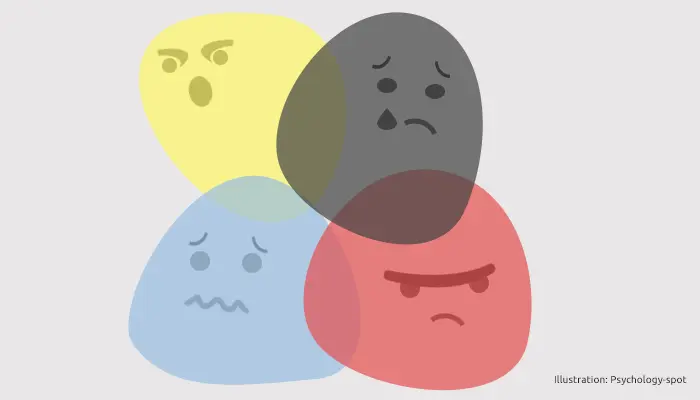
“You worry about nothing”
“You drown in a glass of water”
“You’re overreacting”
“You’re taking it too seriously”
It is likely that on more than one occasion you have heard these phrases or that they have even come out of your mouth. Sometimes these phrases have the objective of helping, encouraging the person to be stronger, but generally they tend to have the opposite effect since they hide the seeds of emotional invalidation.
Emotional invalidation occurs when someone dismisses, ignores, or rejects a person’s emotions and feelings. It conveys the message that what you are feeling is inappropriate, out of place, or not worthy of consideration.
In fact, we can all become crippling at some point, either because we are too wrapped up in our problems or because we don’t know how to deal with emotions whose intensity overwhelms us. The problem is when emotional invalidation becomes a sustained pattern over time. In this case, it can become a form of emotional abuse that must be detected in order to stop it as soon as possible.
The most common types of emotional invalidation in relationships
1. Downplaying affective states
A very common form of emotional invalidation is to downplay the emotions, feelings, and concerns of others. If we see a sad, nostalgic, sorrowful or worried person, instead of trying to put ourselves in their place to understand what is happening to them and how they feel, we simply limit ourselves to saying: “it’s nothing”, “you shouldn’t worry”, ” I don’t see where the problem is” or “you are making a storm in a teacup”.
These types of expressions usually convey the idea that the other’s problems are not that important or worth taking into consideration. Generally, this type of emotional invalidation tends to occur due to simple laziness since it is much easier to downplay the affective states of others than to make the mental effort required to put yourself in their place. Of course, this person may really be “drowning in a glass of water”, but minimizing his problems will not help him stay afloat.
2. Emotional rejection
Emotional rejection is another of the most common forms of invalidation. In fact, it happens quite often with children. When we tell children that “men don’t cry,” for example, we are invalidating the emotions behind crying. It also happens when we blurt out to a person “are you crying over that nonsense?” or “you shouldn’t feel that way.”
The rejection of emotions is usually due to our inability to manage our own affective states and those of others. If we are not comfortable with emotional displays, we will have a tendency to reject their very existence. In fact, the suffering, pain or anguish of the other usually generates great discomfort in those who witness it, so that many times we cannot think of any other way to exorcise that feeling than to refute the emotions of others.
3. Judging the person by his emotions
Emotions exist. They are an automatic response to significant situations. There are no “good” or “bad” emotions, but inadequate expressions of them. For this reason, judging the affective states of the other, with phrases like “you are too sensitive”, “don’t be stupid, you don’t have to react like that” or “you are very weak” is one of the worst types of emotional invalidation.
In this way we do not help the other person, but we tend to make his discomfort worse since he does not feel understood or supported. On the contrary, he perceives that he is being judged and even criticized for what he feels. If we try to put ourselves in his place, perhaps we could understand that he has enough reasons to worry, get angry or feel sad or frustrated. And that emotions are not an expression of weakness but of humanity.
4. Changing the sense of emotions
One of the more subtle types of emotional invalidation is to make a person believe that he is not feeling what he’s really experiencing. It is common when the emotions that are expressed are classified as “negative” and socially disapproved. Expressions like “you’re not angry, you’re just upset” detract from the original emotion, lowering its intensity.
Phrases like “come on, don’t worry, be happy, get up” also hide an invalidation attempt, since are trying to change what the person is feeling for a more acceptable emotion. Sure, there are situations where we need to control our feelings and move on in order to function more adaptively, but when emotions overwhelm us, trying to change them with other emotions only leads to more distress.
5. Denying the right to feel
In this case, the emotion is not minimized, but is directly denied. The phrase “you have no right to feel that way” is the epitome of this type of emotional validation because it makes it clear to the person that his reaction is completely unacceptable. Also phrases like “it could have been much worse”, “that’s nothing” or “if you only knew what I’ve been through” also imply a more veiled rejection of that emotion.
The underlying message that person receives is that he shouldn’t feel a certain way because has no right to, an idea that conveys not only contempt but also selfishness and even superiority. It communicates bluntly that that person’s emotional experience is invalid because someone else assumed the authority to decide how he should feel.
Emotional invalidation, in its different forms, ends up making the other person feel alone, misunderstood, invisible, and small. When we trivialize, minimize or repudiate the feelings of others we are contributing to their growth. Those emotions will always find a way to express themselves, and they will usually come out in the worst way, either through somatizations or emotional outbursts.
Basically, these types of expressions are an attempt to redirect the person towards affective states that are easier for us to manage. The problem is that they usually start from the denial of the original state, invalidating what that person feels. For this reason, it is important that we learn to feel more comfortable with emotional expressions, especially those that we classify as “negative.”
This does not mean that we should not try to comfort the others or that nothing can be said anymore, but we must reflect before speaking and do so from the deepest empathy, making sure that we are moved by an authentic desire to help the other.
When we position ourselves in empathy, we stop judging, minimizing or repressing the emotions of the others and, instead of giving them unsolicited advice, we offer a friendly shoulder and simply say: “I see that you’re feeling bad, how can I help you?”.



